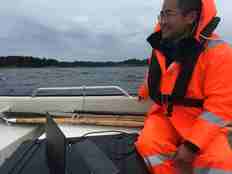New experiment on underwater noise: Determined which directions man-made noise in Bjørnafjorden comes from

Marine scientist Alessandro Cresci in his laboratory.
Photo: Christine Fagerbakke / IMRPublished: 01.12.2023 Updated: 18.12.2023
Where is that scary noise coming from?
This question, which is important, sometimes even existential, to humans, is at least as important to marine animals.
“We know that marine organisms respond to the direction of noise, as for example fish swimming away from ships when they approach. But it is difficult to study how animals in the sea detect and use the direction of the sound”, says marine scientist Alessandro Cresci.
Acoustic particle motion
Now scientists have taken a step further towards understanding how animals perceive man-made noise in the ocean.
Most research has only focused on acoustic pressure, which is measured using a hydrophone. But noise also creates oscillatory motion that is transmitted through the water, which is referred to as acoustic particle motion.
“And it is this particle motion in the water that marine animals use to work out which direction a noise is coming from”, says Cresci.
Successful experiment in Bjørnafjorden
In May 2022, marine scientists performed an experiment in Bjørnafjorden, south of Bergen, to see if they could use animals’ same technique to find out where man-made noises below the sea surface come from.
“We used a device called an acoustic vector sensor, which shows particle motion in 3D. That information enables us to calculate where the noise comes from. Is it coming from the north or south, from above or below?” says Guosong Zhang, a senior engineer at the Institute of Marine Research (IMR).

Bjørnafjorden is a quite a noisy place underwater, due to the noise from ferries, express boats and fish farms, among other things.
“Nevertheless, we managed to detect and determine the direction of all of these noises occurring in the fjord”, says Zhang.
The results of the study have recently been published in the scientific journal Acta Acustica.
“If we observe the behaviour of an animal responding to underwater noise, and we know where the noise is coming from, it is easier to understand why the animal is behaving in the way that it does”, says Zhang.
Useful for offshore wind research
The sound experiment in Bjørnafjorden is part of the IMR’s efforts to improve its understanding of how offshore wind farms will affect marine animals.
“Are animals attracted or scared away by the noise from offshore wind farms? If we are able to determine the direction of underwater noise and combine that with the direction in which the animals are swimming, it can help us to answer those kinds of questions”, explains marine scientist Cresci.
Reference
Zhang, Guosong, A. Cresci og H.I. Browman. «Determining the directionality of anthropogenic noise using an underwater acoustic vector sensor: a case study in a Norwegian fjord». Acta Acustica (2023). Link: https://doi.org/10.1051/aacus/2023043